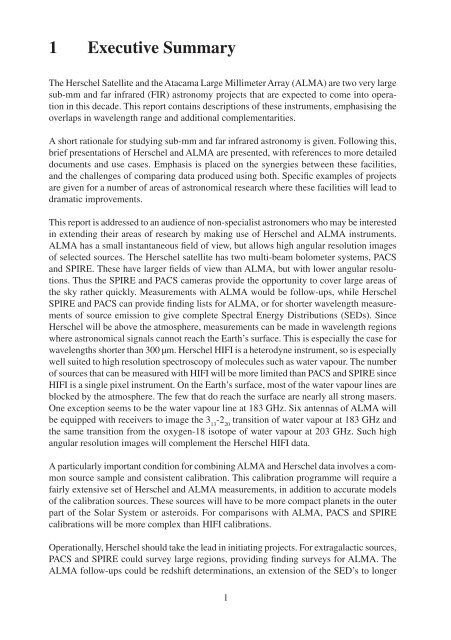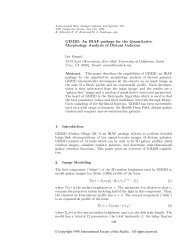4 Comparison of the ALMA and Herschel - ESO
4 Comparison of the ALMA and Herschel - ESO
4 Comparison of the ALMA and Herschel - ESO
You also want an ePaper? Increase the reach of your titles
YUMPU automatically turns print PDFs into web optimized ePapers that Google loves.
1 Executive Summary<br />
The <strong>Herschel</strong> Satellite <strong>and</strong> <strong>the</strong> Atacama Large Millimeter Array (<strong>ALMA</strong>) are two very large<br />
sub-mm <strong>and</strong> far infrared (FIR) astronomy projects that are expected to come into operation<br />
in this decade. This report contains descriptions <strong>of</strong> <strong>the</strong>se instruments, emphasising <strong>the</strong><br />
overlaps in wavelength range <strong>and</strong> additional complementarities.<br />
A short rationale for studying sub-mm <strong>and</strong> far infrared astronomy is given. Following this,<br />
brief presentations <strong>of</strong> <strong>Herschel</strong> <strong>and</strong> <strong>ALMA</strong> are presented, with references to more detailed<br />
docu ments <strong>and</strong> use cases. Emphasis is placed on <strong>the</strong> synergies between <strong>the</strong>se facilities,<br />
<strong>and</strong> <strong>the</strong> challenges <strong>of</strong> comparing data produced using both. Specific examples <strong>of</strong> projects<br />
are given for a number <strong>of</strong> areas <strong>of</strong> astronomical research where <strong>the</strong>se facilities will lead to<br />
dramatic improvements.<br />
This report is addressed to an audience <strong>of</strong> non-specialist astronomers who may be interested<br />
in extending <strong>the</strong>ir areas <strong>of</strong> research by making use <strong>of</strong> <strong>Herschel</strong> <strong>and</strong> <strong>ALMA</strong> instruments.<br />
<strong>ALMA</strong> has a small instantaneous field <strong>of</strong> view, but allows high angular resolution images<br />
<strong>of</strong> selected sources. The <strong>Herschel</strong> satellite has two multi-beam bolometer systems, PACS<br />
<strong>and</strong> SPIRE. These have larger fields <strong>of</strong> view than <strong>ALMA</strong>, but with lower angular resolutions.<br />
Thus <strong>the</strong> SPIRE <strong>and</strong> PACS cameras provide <strong>the</strong> opportunity to cover large areas <strong>of</strong><br />
<strong>the</strong> sky ra<strong>the</strong>r quickly. Measurements with <strong>ALMA</strong> would be follow-ups, while <strong>Herschel</strong><br />
SPIRE <strong>and</strong> PACS can provide finding lists for <strong>ALMA</strong>, or for shorter wavelength measurements<br />
<strong>of</strong> source emission to give complete Spectral Energy Distributions (SEDs). Since<br />
<strong>Herschel</strong> will be above <strong>the</strong> atmosphere, measurements can be made in wavelength regions<br />
where astronomical signals cannot reach <strong>the</strong> Earth’s surface. This is especially <strong>the</strong> case for<br />
wavelengths shorter than 300 µm. <strong>Herschel</strong> HIFI is a heterodyne instrument, so is especially<br />
well suited to high resolution spectroscopy <strong>of</strong> molecules such as water vapour. The number<br />
<strong>of</strong> sources that can be measured with HIFI will be more limited than PACS <strong>and</strong> SPIRE since<br />
HIFI is a single pixel instrument. On <strong>the</strong> Earth’s surface, most <strong>of</strong> <strong>the</strong> water vapour lines are<br />
blocked by <strong>the</strong> atmosphere. The few that do reach <strong>the</strong> surface are nearly all strong masers.<br />
One exception seems to be <strong>the</strong> water vapour line at 183 GHz. Six antennas <strong>of</strong> <strong>ALMA</strong> will<br />
be equipped with receivers to image <strong>the</strong> 3 13<br />
-2 20<br />
transition <strong>of</strong> water vapour at 183 GHz <strong>and</strong><br />
<strong>the</strong> same transition from <strong>the</strong> oxygen-18 isotope <strong>of</strong> water vapour at 203 GHz. Such high<br />
angular resolution images will complement <strong>the</strong> <strong>Herschel</strong> HIFI data.<br />
A particularly important condition for combining <strong>ALMA</strong> <strong>and</strong> <strong>Herschel</strong> data involves a common<br />
source sample <strong>and</strong> consistent calibration. This calibration programme will require a<br />
fairly extensive set <strong>of</strong> <strong>Herschel</strong> <strong>and</strong> <strong>ALMA</strong> measurements, in addition to accurate models<br />
<strong>of</strong> <strong>the</strong> calibration sources. These sources will have to be more compact planets in <strong>the</strong> outer<br />
part <strong>of</strong> <strong>the</strong> Solar System or asteroids. For comparisons with <strong>ALMA</strong>, PACS <strong>and</strong> SPIRE<br />
calibrations will be more complex than HIFI calibrations.<br />
Operationally, <strong>Herschel</strong> should take <strong>the</strong> lead in initiating projects. For extragalactic sources,<br />
PACS <strong>and</strong> SPIRE could survey large regions, providing finding surveys for <strong>ALMA</strong>. The<br />
<strong>ALMA</strong> follow-ups could be redshift determinations, an extension <strong>of</strong> <strong>the</strong> SED’s to longer<br />
1




